By KEVIN RYAN
Saturday, February 17, 2018, was a typical Chicago winter day—cold and blustery, with snow in the forecast. Many South Side fire companies were on the air and picking up following the funeral procession for Chicago Police Commander Paul Bauer, who was killed earlier in the week. Companies were posted on overpasses on I-94 with banners honoring the fallen hero, and aerials, tower ladders, and an elevating platform were raised in his honor.
The Grand Boulevard area of the South Side was the scene of heavy fire activity 50 to 60 years ago and is now undergoing a renewal. Buildings are being renovated, and new buildings of lightweight construction are being built.
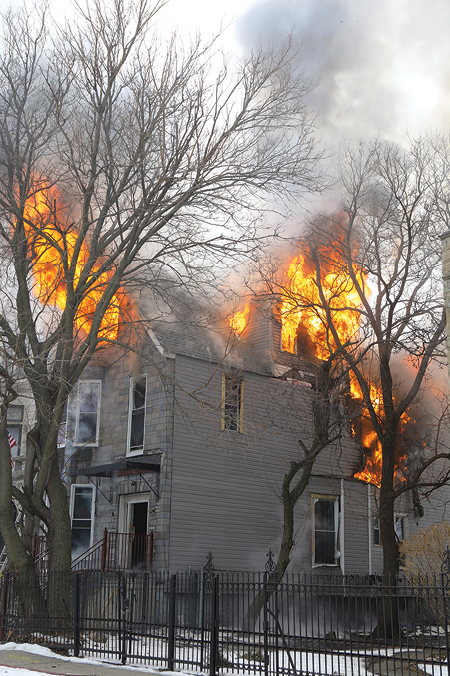
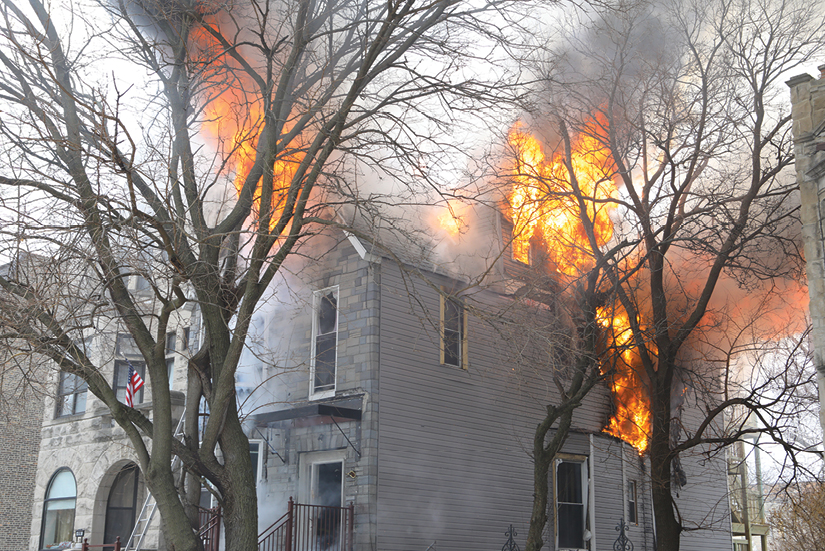
(1, 2) Conditions on arrival: heavy fire in sectors A, C, and D on floors two and three and the attic. (Photos by James Regan.)
The Building and Exposures
One such building under renovation was 4912 South Michigan Avenue. Originally constructed in 1895, the 25- × 65-foot 2½-story wood-frame building was being completely renovated. It was originally a single-family dwelling but had been converted to apartments years ago. Most of the walls had been removed, and wood framing existed on all floors. Stairways were 2 × 4s, which created an access problem. Originally of balloon-frame construction, that feature was being eliminated. The only exposure was on the B side, which was a 2½-story occupied Graystone (a building, 25 feet × 75 feet, two or three stories, with a front facade made from gray limestone, built after the Chicago Fire and prevalent in older neighborhoods) that butted right up against the fire building. Fortunately, there were no openings in either building, but they touched one another.

(3) Lines from Engines 45 and 50 going in the front door. Truck 15 has thrown a 20-foot ground ladder to the second floor. Trees obstruct access. The proximity of the B exposure is shown.
The Fire
The initial response consisted of Engines 45 and 50, Trucks 37 and 15, and Battalion 5 (myself). Tower Ladder 37 was on the air following the memorial and was first on scene and reported a working fire. This raised the response to include Squad 5, Command Van 2-7-4, Rapid Intervention Team (RIT) Truck 18, a RIT battalion chief, two advanced life support ambulances (one for RIT and one standby), and a RIT EMS field supervisor.
I approached the fire by the quickest route from the firehouse. Turning north off 51st street onto Michigan Avenue, a five-lane, one-way southbound street, I immediately observed the whole street obscured by heavy smoke near the fire building. I had to be very cautious approaching the scene through the smoke, as I didn’t want to strike any cars or pedestrians in the smoke-filled street. I completed my check of the three visible sides of the building and found fire on all floors, with heavy fire venting on the D side on the second floor and on all three sides from the third floor and attic. I immediately requested a still and box alarm, which brought two more engines, another truck, two more battalion chiefs, and the deputy district chief of District 1 to the scene.
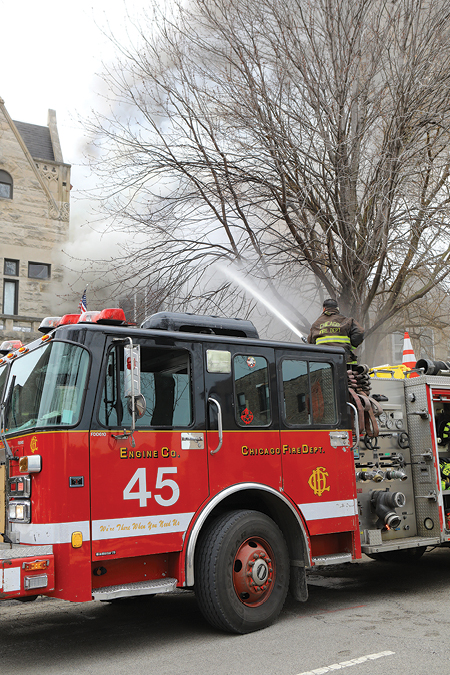
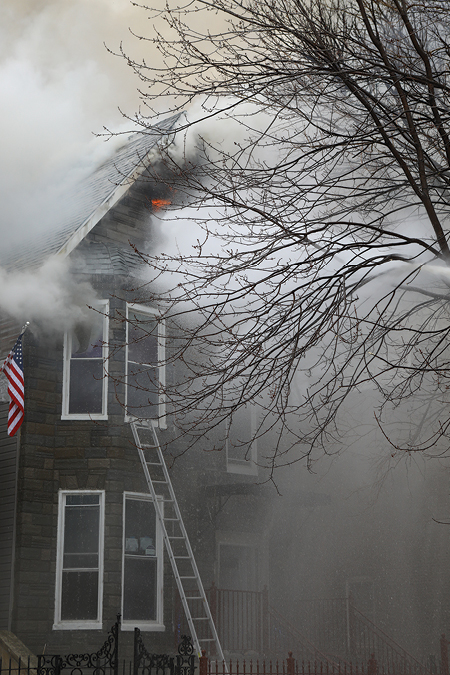
(4, 5) Engine 45 blasts the attic with the deck gun.
Operations were just about a textbook example of all the points raised in “Fires in 2½-Story Wood-Frame Dwellings” by Bill Gustin (Fire Focus, Fire Engineering, June 2017). The first goal was to protect exposure B, but with no space at all between the buildings, the only and best option was to extinguish the fire.
Operations
Engine 45 approached from the north and pulled past the building, in front of Tower Ladder 37, already on scene. Engine 45 stretched 150 feet of 2½-inch line with a gated wye with 100 feet of 1¾-inch line attached. Members went to work on a small fire on the first floor and the extension to the second floor. Engine 50 backed down from the north, stretched a similar line, and went to work on the second and eventually third floors.

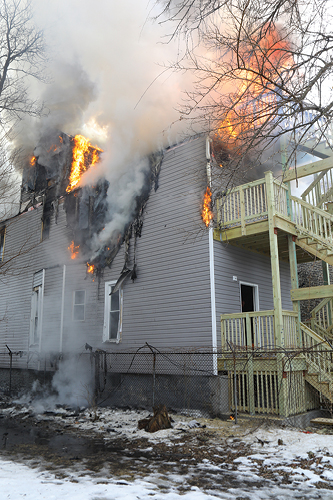
(6) Heavy fire in the C/D corner. (7) Knockdown appears on the second floor, but there is still heavy fire in the third floor and attic.
The very heavy volume of fire in the attic and third floor warranted fast action, so while the handlines were being led out, I instructed Engine 45 to hit the attic window with its deck gun to slow down the fire’s progression. The third engine, Engine 84, stretched a 1¾-inch line to the rear and ultimately the second and third floors. Truck companies forced entry and completed searches when able. Roof ventilation was not possible because the building was tightly surrounded by trees on the A and D sides. Squad 5 set up an elevating platform on side C off the alley.
Knockdown was rapid, but many hot spots existed throughout. It was decided that the safest option was to hydraulically overhaul with Tower 37’s and Squad 5’s elevated streams. All personnel were withdrawn, a personnel accountability report (PAR) was completed, and the two streams were put to work for 20 minutes. After water was permitted to drain from the building, Battalion 6 and I performed a detailed inspection of the building. On completion, Engines 45 and 84 operated two 1¾-inch handlines with Truck 15 and Squad 5 for final washdown and overhaul of the second floor, third floor, and attic areas. Battalion 6 and I were interior safety chiefs until all members exited the building.

(8) Tower Ladder 37 moves in for hydraulic overhaul and removes tree branches for access.
Lessons Learned and Reinforced
- The incident commander must obtain a clear view of all sides of the building on arrival.
- Calling for additional resources immediately is a must. A still and box assignment in Chicago brings four engines, four trucks, a squad, auxiliary equipment, and about 50 personnel.
- The severe exposure on the B side warranted a fast attack. The deck gun knocked down the fire in the front and prevented the fire from jumping from one roof to the other.
- The wide-open floors and walls contributed to heavy fire involvement on arrival. Fortunately, this building was solidly built, and collapse was not considered to be an issue.
- The first two engines secured their own hydrants, each with a strong water supply.
- Because of the aggressiveness and professionalism of these fire companies, there were no injuries and there was no fire extension to the exposure building.
KEVIN RYAN is a battalion chief and a 31-year veteran of the Chicago (IL) Fire Department. He has spent much of his career in busy companies on the South Side and is very familiar with building construction in the neighborhood where this fire occurred.

